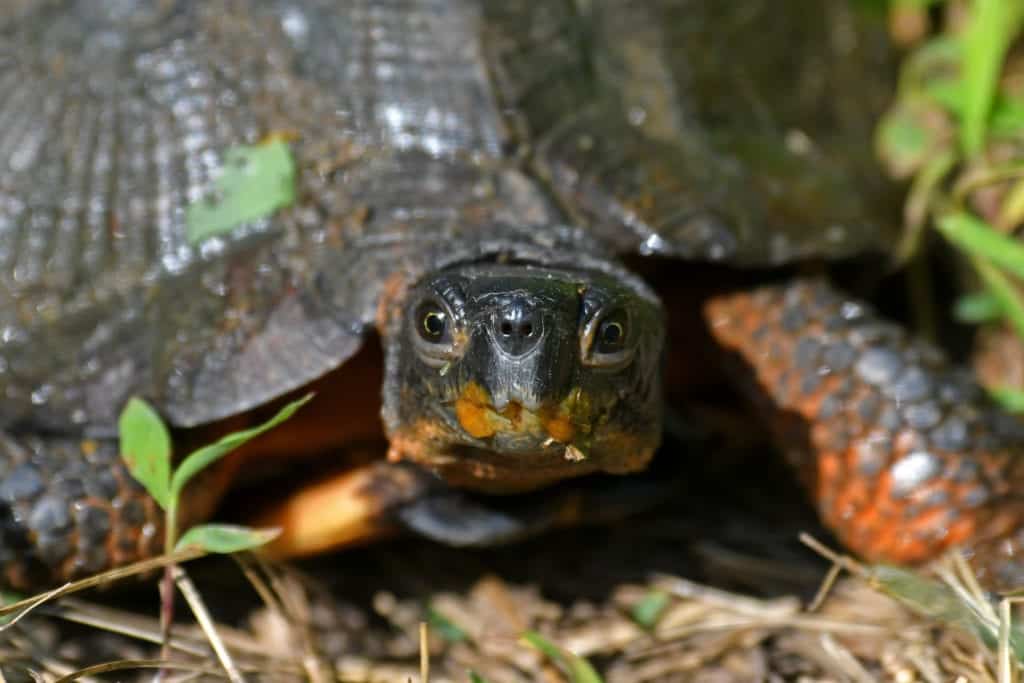
This is the fourth post in our series on the wildlife impacts of Central Maine Power’s proposed New England Clean Energy Connect (NECEC) transmission line project. As we wrote in our introductory post, Maine Audubon feels strongly that NECEC and its mitigation plan offer unsatisfactory protections for Maine wildlife and is especially deficient in its consideration of habitat fragmentation.
Prior posts considered the impacts of forest fragmentation on ground-nesting birds like the Ovenbird, and species like the American Marten that need large areas of unfragmented habitat (link).
In considering the impacts of NECEC and habitat fragmentation on Maine wildlife we will now consider species that require connected streams and ponds, like the Wood Turtle.
An ICUN Red List Endangered Species, Wood Turtles are native only to the northeast and northern Great Lakes states. They’re beautiful turtles, with a red and yellow cast to their bodies and pyramid-shaped scutes on their shells.
Wood Turtles spend their time split between land and water, and are never found far from a flowing stream. They’re omnivores, searching both through the forest undergrowth and in moving waters for plants, fungi, and animals including beetles and slugs. During the coldest parts of the year the turtles retreat to a place safe from most predators: the muddy bottom of a flowing stream. Here they lay dormant until it’s warm enough for them to continue searching for food.
A Wood Turtle’s reliance on water means that they require connected streams and ponds to thrive. These waters need large old trees in the shoreland habitat to provide shade to keep the water cool, and that eventually fall into the stream to create places to hide and create deep cold-water pools. The shoreland area is also important as a travel corridor for numerous animals, including wood turtles. The construction of the NECEC corridor may disrupt the ability of these turtles to move along connected waterways, especially at two areas where Wood Turtles are known to occur along the Sheepscot River in Alna.
The corridor could hurt waterways used by Wood Turtles by building through waterways or by causing water quality to decline from erosion or sedimentation from nearby construction. Stream crossings constructed for the project may change topography and water temperature, important for Wood Turtles as well as other important species including the Northern Spring Salamander.
In its environmental analysis for the NECEC project, CMP has confirmed that it will follow environmental construction guidelines to limit water quality degradation and also provide training for workers to recognize and respond to Wood Turtle sightings. Hopefully these measures will be effective.

However, the corridor right-of-way itself is also a concern to these turtles, even after construction has finished. Wood Turtles can be attracted to forest edges like that of a right-of-way, finding shrubs for foraging and open sand for nesting. However, they have been known to be hit by mowers during right-of-way maintenance, and nests can be destroyed by ATVs attracted to the open right-of-way.
Wood Turtles are threatened across their range from habitat destruction, motor vehicle strikes, the pet trade, and other causes. They are a Species of Greatest Conservation Need in Maine and listed as Endangered on the IUCN international Red List. We need to ensure that NECEC proponents are considering the entirety of possible impacts to Wood Turtles so that those impacts can best be avoided, mitigated, or compensated. Such consideration is essential for the survival of the Wood Turtle in Maine and across its range.
